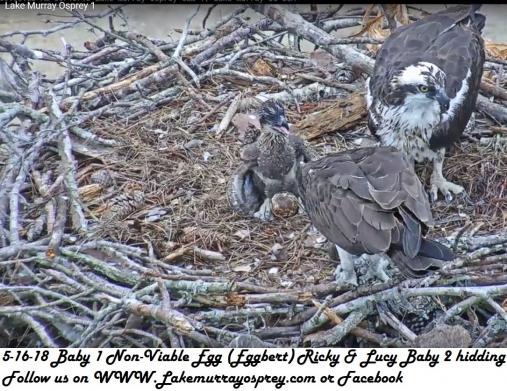Unhatched Eggs
An unhatched egg is in the nest some call it Eggbert or Dudley. This is not uncommon to find a non-viable egg in a nest for many reasons. Here is a some wonderful info on a non-viable egg from my friend, most know her as, Lady Hawk.
An egg fails to hatch either because it is infertile or because it is non-viable. An egg is infertile if the ovum is not fertilized by male sperm before it begins travelling down the female’s oviduct. This might be because of badly timed or incomplete copulation or because the sperm was defective or of insufficient numbers. In the wild, infertility is much less common than non viability.
An egg is considered non-viable if the embryo of a fertilized egg does not properly develop. In this case the egg was fertilized but something happened to caused the embryo to not fully develop.
Non viability can have many causes, among them:
1) the egg does not have sufficient nutrients to nourish the developing embryo, which would be dependent on the health and diet of the female while the ovum was moving through her oviduct;
2) the egg is not properly incubated; by a few days after the egg is laid the embryo must be kept at a stable temperature between about 95 and 104 degrees F. (an egg can be left incubated for short periods but rarely more than a few minutes at a time, depending on the ambient air temperature, the depth of the nest cup, and the presence or absence of precipitation.
3) the egg has not been turned often enough during incubation; this is necessary to prevent the embryo from adhering to the membranes that surround it, to bring the yolk that holds the embryo into contact with fresh stores of protein- and water-rich albumen (the “white” of the egg), to enable the capillaries in the membranes around the embryo to develop evenly throughout the shell (studies have shown that if these capillaries line less than 95% of the shell the embryo will have less than a 50% chance to hatch), and to be sure the chick is properly positioned (beak upward) at hatching time;
4) the eggshell has been penetrated by bacteria or a chemical (as can happen if adults forage in a human landfill);
5) the shell is broken before the chick has fully developed inside, which can occur if the incubating parent moves suddenly in response to an unexpected event like an intruder—avian or mammalian including human disturbance—or inadvertently steps on or jostles the egg too vigorously; the shell becomes thinner and more fragile as the incubation period proceeds because the chick absorbs some of the calcium into its developing bones.
Sometimes a chick will begin the pipping process but die before it is able to fully emerge. The hatching process is strenuous and can take a couple of days. Once the shell is cracked it is more fragile and a false step by parent or already hatched sibling could damage it before the hatching process is complete. Bacteria can easily seep in through a cracked shell and weaken or kill the chick. If the egg turns over so that the head and beak are on the lower part of the egg, the chick could suffocate in the fluids inside the egg or in matted nesting material. In most cases it is impossible to know whether it is infertility or non viability that has caused an egg not to hatch.
Depending on the cause and the timing within the incubation period, a non-viable egg often will break apart, which of course the parents will realize. The egg may be trampled into the nest or even partially consumed by adults or fed to a hatched nestling. An infertile egg usually remains intact throughout the incubation period.
I hope you find this info helpful in all your adventures in nature.
